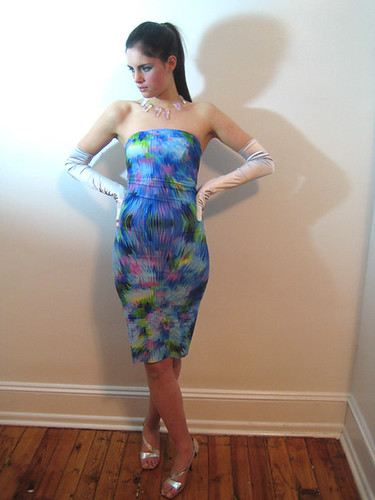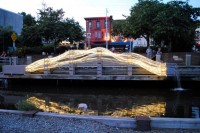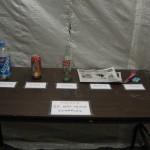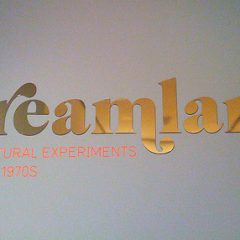Post by K-Fai Steele
Lobo Mau (“Big Bad Wolf” in Portugese) is a new Philadelphia-based textile and fashion design company. It is the brainchild of Nicole Haddad and Renata Certo-Ware, Philadelphia natives who specialize in digitally printed textiles – one of the newest, most environmentally-friendly forms of printing. On December 13th, Lobo Mau launched the design of their newest creation: 3-D digitally printed dresses at Bacai Boutique in Manayunk [at 4228 Main Street, Philadelphia, PA 19127].
As you approached the store, you saw some of the models dancing in the store’s window (see the video at the bottom of the post- a cry back to Amsterdam’s more liberal times? Fittingly, the majority of those brothel windows have since been converted into high-fashion boutiques).
The fashion show was more of an art opening/trunk show, with wine and food and people chatting while the models walked amongst the crowd in the Digital Dresses (there was no cat walk) and a dj was playing music by the door. The crowd itself, which was constantly flowing in and out from the street, ranged from 20-somethings to people who seemed like patrons of the arts in general (older people with quirky glasses).
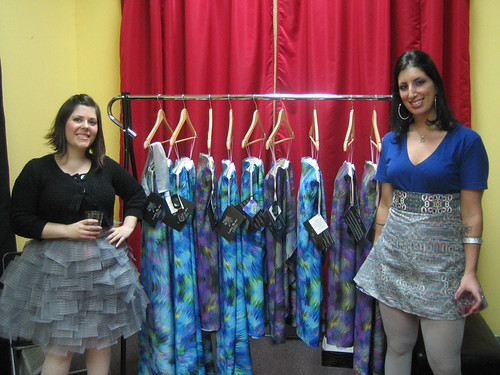
Lobo Mau: Haddad on the left and Certo-Ware on the right, wearing some of their own work (the skirts). In between them is a rack of their digitally-printed dresses.
The textile patterns are designed by Haddad and Certo-Ware and then printed in Korea. The fabric is shipped back to the United States and is tailored by Lobo Mau’s main production person, Jamie Grace-Duff.
There was a box of 3-D glasses at the door to the gallery/fitting area. Grace-Duff stood in front of a curtain, measuring tape around her neck, sizing clients for the Digital Dresses. Lobo Mau’s textile designs were on display; some in the stages of design and others that have already been printed onto fabric. Digital printing allows the designer access to a much wider spectrum of colors, as opposed to screen printing where color choice is more limited.
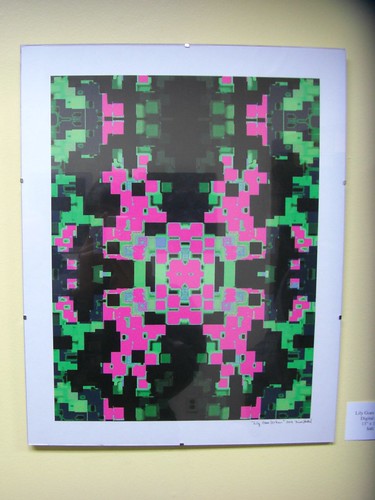
“Lily Goes Urban” one of Lobo Mau’s designs for a digitally printed textile [perhaps this is a reference to Lily Pulitzer prints!–the editors]
The dresses themselves are simply cut – strapless with a boned inner corselette, beautifully tailored by Grace-Duff (an elegant answer to the awkward built-in shelf bra). Haddad describes them as “dresses for dancing” or what could easily constitute clubwear. The Cocktail Dress sells for $250, and the longer Evening Gown for $350. Because the fabric was so exciting with the 3-D element, it would’ve been interesting to see how Lobo Mau would experiment with more adventurous styles. However, Edgar Bacai, the owner of Bacai Boutique reports that most of the clients are local young professionals and college students (Nicole Miller is down the street). They may not necessarily be looking for the oddest couture styles.
The use of digital printing in fashion is something that’s taking off with other designers as well. At fashion week in Paris and London this year, designers such as Manish Arora and Matthew Williamson were showing recent techniques in digital printing (Lobo Mau cites Arora as one of their influences).
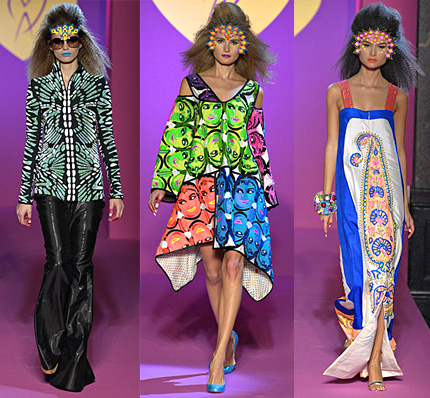
Manish Arora, Paris Fashion Week, 2008
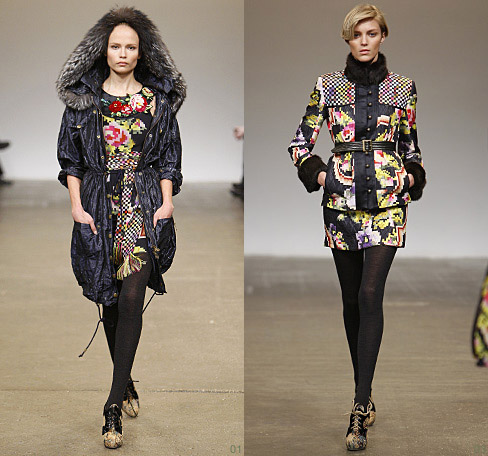
Digital printing is by far one of the most “green” techniques of printing textiles, besides natural dyes from fruits or vegetables. When fabric is silkscreened or submersion printed (heat pressed from a digital print), there is a large amount of chemical and dye runoff. In India and China, the chemical waste from solvents and inks is a major problem in local watersheds. Even in the United States, pollution from screen printing is an issue that has come to the public’s attention through the EPA. Each state has different regulations about silkscreen waste disposal. With digital printing, there is no waste from dyes or solvents.
In the meantime, digital printing is still prohibitively expensive, but designers like Lobo Mau are definitely on the forefront of a new textile printing trend, particularly with their 3-D element. Digitally printed textiles can have a tendency to all look the same– busy and soft. As digital printing becomes more common, true innovation of the technique would be to take what is unusual about the process and exploit it.
Footage from outside of Lobo Mau’s opening party at Bacai Boutique, December 13, 2008.
More information about Lobo Mau can be found on their website lobomaudesigns.com. Their Etsy page is where you can buy the Digital Cocktail and Evening dresses, as well as some ready-to-wear items.
–Artist K-Fai Steele last wrote for artblog about the MoMA exhibit Dreamland: Architectural Experiments since the 1970s.


